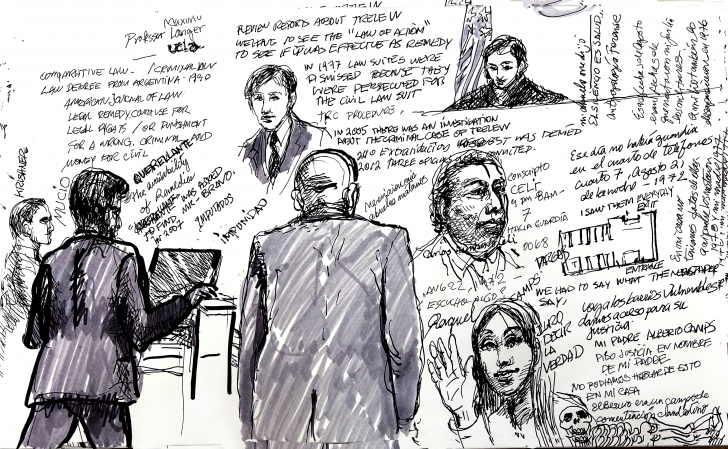Drawing: Carlos Llerena Aguirre
Day 4 – Thursday, June 30, 2022:
In the final minutes of Marcela Santucho’s video deposition, she testified that after losing her mother to the Trelew Massacre her family was forced to go into hiding. She recalled a very difficult time when she felt completely alone. She was not aware of Mr. Bravo’s involvement until the 2008 criminal trial in Argentina. She concluded by describing her admiration for her mother and her goal to seek justice for her killing.
Plaintiffs called expert witness Dr. Rodolfo Guillermo Pregliasco, Director of the Forensic Physics Department at the Atomic Center in Buenos Aires. He presented a reconstructed blueprint of the 1972 Almirante Zar Naval Base (“Base”), work initially performed in 2007 for the criminal court in Argentina. Examining the various paint layers and wall markings, he created a diagram of the cell block and a scaled image depicting the 19 prisoners standing side-by-side in the hallway which spanned four feet, eleven inches. Analyzing the lower bullet hole found in the wall at the Base, he was able to determine its trajectory depending on firing location which he physically demonstrated for the jury: if from back where the prisoners stood at the beginning of the hallway, he held the imaginary gun overhead; if from between the hallway and wall, he held the imaginary gun at chest level; and if from closer to the wall, he held the imaginary gun at waist level.
Under cross-examination, Dr. Pregliasco acknowledged that the Base had been renovated numerous times between 1972 and the first time he visited in 2007. When asked if he ever saw blueprints, records, or construction plans, Dr. Pregliasco said no, despite requesting this information from the military, which had actually asked for copies of his reconstructed plans. He was questioned about two photographs published in an Argentine newspaper days after the Trelew Massacre showing outer and inner doors to the bathroom located near the cells, the rear wall of which showed the lower bullet hole described above as well as a higher bullet hole in a window (that he testified no longer exists). Dr. Pregliasco explained that he used the photographs to help create the reconstruction because the original outer bathroom door was still in the same place when he visited in 2007, and the images helped him locate the patched area where the lower bullet hit. This in turn, Dr. Pregliasco explained, aided him in determining the trajectory of the bullet when it was fired. On redirect examination, Dr. Pregliasco clarified that he scraped paint off the wall to find the bullet hole, which had been repaired by synthetic plaster or filler.
Plaintiffs offered expert testimony of Professor Maximo Langer, from the University of California, Los Angeles School of Law and specializing in comparative analysis of the Argentine and American legal systems. Professor Langer outlined five lawsuits brought by victims or surviving family members of the Trelew Massacre between 1972 and 1974. He explained that these cases never advanced and were formally dismissed in 1977. Additionally, immediately following the massacre, the military government released a decree “essentially criminalizing” accounts of the events at Trelew that differed from that provided by the military. Professor Langer explained that because Argentina’s attempt to extradite Mr. Bravo was unsuccessful, the criminal trial proceeded without him, resulting in his fellow soldiers’ convictions in 2012.
The jury watched a video deposition of Carlos Celi, a conscript at the Base during the massacre. Mr. Celi explained that his job at the Base was manning the only phone available to take outside calls. He emphasized that the phone, which “was to be manned at all times,” was housed in a room next to the cells where the massacre took place. He indicated that on the night of the massacre, however, the telephone room was not manned. Mr. Celi recounted that in the aftermath of the massacre the conscripts were instructed to stick to the official story propagated by the military. But he did not believe that the prisoners had attempted to escape because the Base had too many guards, too few exits, and was too remote.
Plaintiff Raquel Camps, daughter of victim Alberto Camps, testified through tears that she never knew her father and was told by her grandparents that he was killed along with her mother in a car crash. Later in life she learned from a newspaper that her father was a victim of the Trelew Massacre and subsequently killed on its fifth anniversary. She explained that both her mother and uncle were later disappeared. It was not until 1998 that she received reparations from the government for the deaths of her family members. Ms. Camps eventually obtained her father’s death certificate detailing the tragic circumstances of his death in addition to his remains. The body of her mother, however, was never found.
Ms. Camps testified that she began seeking justice for her family, and in 2005 a criminal case was brought against the soldiers responsible for the shootings. When asked about her safety during the case, she explained that she was very fearful for her family but took comfort in being placed in witness protection. Ms. Camps testified that after the exhausting litigation the three soldiers were finally convicted; only Mr. Bravo remained unpunished. She reported that it was not until 2008 that she learned Mr. Bravo was in Miami, Florida. When shown a photograph of victim Alberto Camps smiling, Ms. Camps tearfully confirmed that was the only picture she had of her father. She concluded by declaring that she brought this case against Mr. Bravo because he had been a free man for too long and she could not wait any longer.

